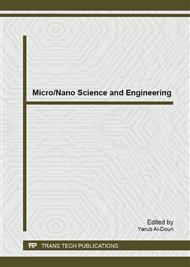p.575
p.580
p.585
p.590
p.595
p.600
p.605
p.610
p.614
Modeling Development of a High-Sensitivity Escherichia coli O157:H7 Detection Based on SH SAW Sensor
Abstract:
Surface acoustic waves based devices were initially developed for the telecommunication purpose such as signal filters and resonators. The acoustic energy is strongly confined on the surface of the surface acoustic waves (SAW) based devices and consequent their ultra-sensitivity to the surface perturbation. This has made SAW permits the highly sensitive detection of utterly diminutive charges on the surface. Hence, SAW based devices have been modified to be sensors. Food contamination has become critical issue and sensitive detection devices are needed urgently as small amount of harmful bacterial pathogens such as Escherichia coli (E.coli) O157:H7with the dose fewer than 100 organisms in food products or water is enough to cause serious gastrointestinal illness to human. Therefore, ultra-high sensitive, label free biosensors have been designed in this research for the low concentration E.coli detection. After the saturated development in telecommunication filed, SAW sensors were developed for gas detections and have been moving towards biological detections recently. Shear horizontal surface acoustic wave (SHSAW), one of the SAW based types is most suitable for the liquid based application as it has the advantage of acoustic energy is not being radiated into liquid. Therefore, SHSAW device has the potential to provide high-performance sensing platform in this research. There have been a lot of complicated theoretical models for the SAW devices development since 1960 as signal filters and resonators such as from delta function model, equivalent circuit model, to the current SAW models such as coupling-of-modes (COM) model, P-matrix model and finite element analysis (FEA) model. However, SHSAW device in this research is not meant for signal filter or resonators but used for surface sensing purpose, therefore the simplicity method of the modeling is presented in the paper for the E.coli detection sensor development.
Info:
Periodical:
Pages:
595-599
Citation:
Online since:
April 2014
Authors:
Price:
Сopyright:
© 2014 Trans Tech Publications Ltd. All Rights Reserved
Share:
Citation:


